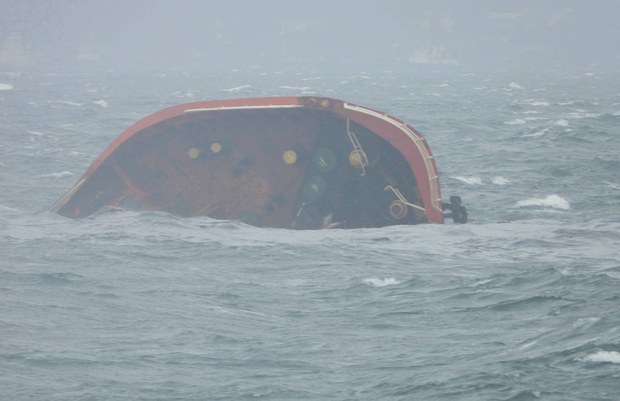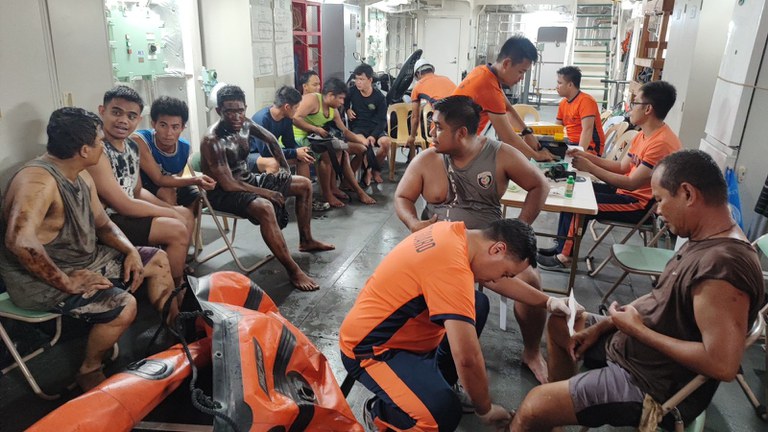Oil tanker sinks in typhoon-whipped Philippines’ Manila Bay
2024.07.25
Manila
 A photo released by the Philippine Coast Guard shows a part of the sunken Philippine-flagged MT Terra Nova, July 25, 2024.
A photo released by the Philippine Coast Guard shows a part of the sunken Philippine-flagged MT Terra Nova, July 25, 2024.
A Philippine tanker carrying 1.4 million liters of industrial fuel sank in Manila Bay on Thursday in rough seas, creating an oil spill and leaving a crew member dead.
Heavy rains caused by Typhoon Gaemi–also known as Super Typhoon Carina–and an enhanced seasonal monsoon complicated efforts to contain the oil spill. Some 16 people were rescued from the tanker, officials said.
Thursday’s accident came as flooding began to subside in parts of the Philippines. At least 21 people died due to the rains and floods, while five others were missing, according to national police spokesperson Col. Jean Fajardo.
An aerial survey by the Coast Guard shows an oil spill covering an estimated two nautical miles in Manila Bay on Luzon, the largest Philippine island.
The spill is about 5.6 nautical miles [10.4 kilometers] east of land and moving east to northeast, Philippine Coast Guard spokesman Rear Adm. Armando Balilo said in an incident report Thursday, potentially putting it on a path to the capital Manila’s coastline.
“Marine environmental protection personnel have also been mobilized to combat the oil spill,” he said.
President Ferdinand Marcos Jr. on Thursday ordered several government agencies to assess the oil spill’s environmental impact.
“Basically, what we need to assess is where was the capsized vessel? The fuel is being released, what are the tides? What are the winds? Where is it headed? So that we can prepare ahead of time. We need some determinations of that,” said Marcos during a briefing.

The Philippine-flagged tanker Terra Nova was heading to the central Philippines when it was battered by heavy waves and sank at 1:00 a.m. about 3.6 nautical miles (6.7 kilometers) east of Lamao Point in Manila Bay.
The Terra Nova had been allowed to depart port after Typhoon Gaemi exited the Philippine area of responsibility and headed to Taiwan.
Environmental disaster
“The sunken tanker MT Terra Nova is a ticking time bomb that further imperils the health, safety and livelihoods of coastal communities around Manila Bay,” said Greenpeace climate campaigner Jefferson Chua.
He said the sinking poses a risk to nearby towns and other areas already heavily affected by extreme rainfall from Typhoon Gaemi and the southwest monsoon.
“This one-two punch of calamities highlights just how severe the danger fossil fuels can be to our environment and vulnerable communities,” Chua told reporters.
“With inadequate government social and financial support for recovery, communities are left in the lurch, as in the case of the MV Princess Empress last year,” he said.
In March last year, MT Princess Empress sank in the vicinity of waters off Naujan, in Oriental Mindoro province with 800,000 liters of industrial fuel. Its 20 crew members were rescued.
The coast guard said the incident left an oil spill measuring at least two to three kilometers (1.2 to 1.9 miles) long. Authorities later found the ship’s tanker, which had sunk to a depth of 400 meters (1,312 feet), and siphoned off its contents.
The worst spill in the country was recorded in August 2006 when the tanker M/T Solar 1 sank off the coast of the island province of Guimaras, spilling more than 2.1 million liters of bunker fuel.
Floods and rains
Incessant rains and heavy flooding prompted at least 21 cities and municipalities to declare a state of calamity, according to the National Disaster Risk Reduction and Management Council on Thursday.
Among these areas were the capital Manila and its surrounding suburbs.
Fajardo said Valenzuela and Malabon, cities just north of Manila, were among the heavily affected areas, with floodwaters reaching the rooftops of homes.
“Rescuers only managed to reach some of the flooded areas … using rubber boats,” Fajardo told reporters. “Our focus is to reach the isolated areas here in metro Manila.”
The ferocity of the storm took many by surprise, with non-stop rains Wednesday transforming many roads into virtual rivers that sent cars floating and commuters climbing on passenger bus rooftops.
Wednesday’s flooding was the worst to have hit Manila since 2009, when Tropical Storm Ketsana flooded large parts of the capital, resulting in more than 900 deaths.
Four years later, in November 2013, more than 6,500 people died and scores were reported missing after Super Typhoon Haiyan struck the central Philippines and caused massive storm surges.
Basilio Sepe from Manila and Mark Navales from Cotabato City, southern Philippines contributed to this report.







